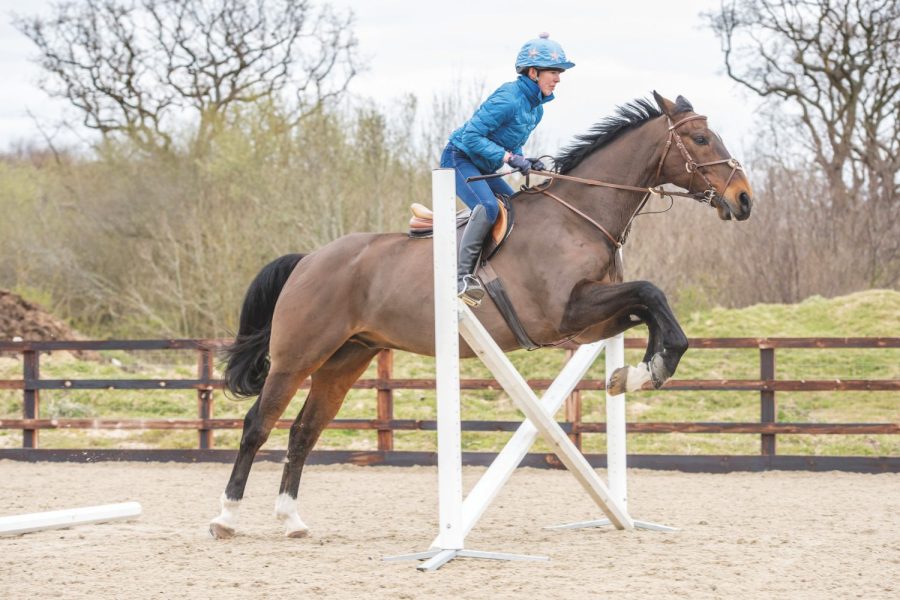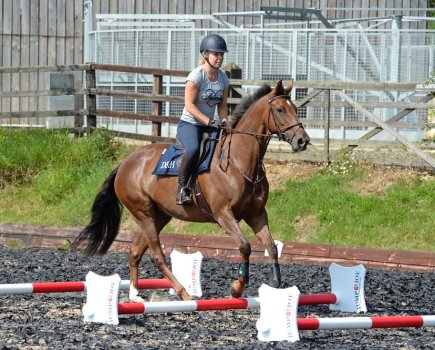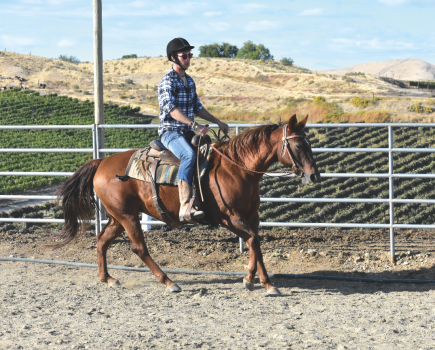Is your horse particularly keen and eager about their work — so much so that they often anticipate what they’re about to be asked to do and shoot off before you’ve applied the aids?
It’s hard to relax or enjoy jumping a strong horse if you don’t feel in control. Strong, sharp horses are often clever and will soon suss what you’re going to ask them to do, but it’s possible to channel their enthusiasm so that you don’t end up in a battle, as international showjumper Matt Lanni explains.
“If your horse pulls and you pull back you’ll get into a battle and neither of you will develop,” says Matt. “Instead, you’ve got to allow your horse to relax and go forwards, while keeping things safe and in control — upping your confidence levels in the process.”
Sounds like a win-win to us. Matt’s tried and trusted methods are easy to replicate in a school or any small fenced off area and will work whether you plan to stay on the flat, go showjumping or cross-country, or simply up your control out on a hack.
Exercise 1
Think positive when jumping a strong horse
Some horses are keen to get cracking right from the word go. The key to jumping a strong horse, says Matt, is to get them on your side — and keep them there.
How to ride it
- Warm up on a loose rein, in walk, encouraging your horse to stretch.
- Pop a cone or pole at each end of your schooling area, so you can ride a 10-12m circle around it, on both reins.
- Ask for trot along one long side and then move onto your circle.
- Simply stay on this circle until you can feel your horse start to lengthen and relax.
- Go large and, if you feel your horse start to take a hold, repeat the circle exercise.
- Remember, strong, forward-going horses will simply get stronger if they feel restricted. By allowing them forwards on a small circle you’re letting the confines of the movement keep them in check, reducing the amount of contact you need.
Top tip!
Simple yet effective, riding a 10-12m circle has multiple benefits. For a start, it enables you to allow your horse forwards safely; you can ask them to lengthen their stride, secure in the knowledge that they can’t run away with you. The result? A horse who’s in a more trainable, relaxed frame of mind from the off — and a more confident you as you learn you can control the pace.
Exercise 2
Embrace the pace when jumping a strong horse
A lot of very sharp horses have a tendency to sit behind the contact and then surge into action, especially once they clock a fence. So how can you learn to control a strong horse once the jumps come out? It all boils down to the same message, says Matt.
“You’ve got to find a way to allow your horse to lengthen and stretch. The more time you can spend not overpowering them the better. You’ll never encourage a horse to relax and be less strong if you’re constantly holding them tight, and if you hold tight you’ll lose the rhythm, especially in canter.”
How to ride it
- Set yourself up for success by making your schooling area really work for you.
- In this instance, the smaller and more confined the area the better; let the walls of the school do the hard work for you, slowing your horse down so you don’t get into a battle.
- Using poles on the ground, a small cross-pole or an upright, introduce the idea of jumping – while developing your brakes – with Matt’s simple serpentine exercise.
- Set three poles/jumps up on the centre line, with a ground pole one stride out.
- In trot, make a turn off the left rein at the A or C end and pop the first jump, using the far wall or fence to slow you down naturally.
- Continue in a serpentine shape, so that you jump all three fences.
- Make a 10-12m circle to gather your horse up if they’re getting strong, and once they’re balanced and moving forwards nicely, repeat the exercise.
- Vary the way you turn after a fence – random is good to keep your horse guessing and means they need to wait and listen to you.
- The jumps can be tackled in any order.
Remember…
Being able to give with the rein and use the edges of the school to slow you down after each pole or fence has multiple benefits. It will up your confidence, give your horse the freedom they want, and encourage them to sit on their haunches as they approach the edge of the arena and turn, without you having to do much.
Exercise 3
The element of surprise
As long as it is safe to do so — remember every horse is an individual and some exercises will suit some better than others — you could consider using the element of surprise when you’re jumping a strong horse.
How to ride it
- Set two jumps up, 22 yards apart, with a ground pole before each.
- Trot over the first element, then ask for halt before the second ground pole.
- Keep everything calm and relaxed and think ‘jump, sit up, stop’.
- Make a turn, in either direction, and ask for trot again.
- Is your horse getting strong after a few jumps? Riding a 10-12m circle two or three times at either end of the school, and allowing them to lengthen, will enable them to relax into the fence and naturally make the distance.
- Progress to jumping both fences together; practise trotting to the first fence, then transition back to trot for the second until this becomes smooth and your horse is not taking charge to the second.
Remember…
Teaching a strong horse to relax and wait for you is key, and will up your control outside of the arena when you’re at a show or hacking out – but it takes time.
Exercise 4
Rehearse at home
“You have to do lots and lots of work at home, training your horse to wait and listen, and arming yourself with a well-rehearsed routine you can replicate, in parts, at a show,” says Matt. “The key is allowing your horse forwards, safely, without letting them run away.”
How to ride it
- Learn what you can do in the week or so before a competition to help your horse be level-headed and listening on the day – maybe lots of hacking or 24/7 turnout.
- If you’re aiming for a dressage test, practise the movements at home in the wrong order to prevent your horse taking control and second guessing what you’re going to ask.
- Allow yourself lots of time at a competition to warm up, and repeat the exercises we’ve run through here to allow your horse plenty of controlled forwards movement.
- If your horse is a hot head, keep them moving forwards in the warm up and avoid asking for anything that will increase tension in their body and make them feel confined, such as rein-back.
- Remember, you can replicate all the exercises we’ve mentioned here in the collecting ring in some form or other.
Matt Lanni is an international showjumper and UKCC Level 3 BS coach. He is based at Halefield Stud in Northamptonshire. Lead image by Your Horse Library/Lucy Merrell.








